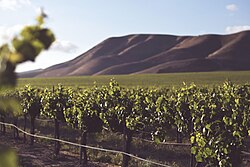Santa Barbara County wine is an appellation that designates wine made from grapes grown mostly in Santa Barbara County, California which is located approximately 50 miles (80 km) north of Los Angeles County. County names in the United States automatically qualify as legal appellations of origin for wine produced from grapes grown in that county and do not require registration with the Alcohol and Tobacco Tax and Trade Bureau (TTB) of the Treasury Department.[9] TTB was created in January 2003, when the Bureau of Alcohol, Tobacco and Firearms, or ATF, was extensively reorganized under the provisions of the Homeland Security Act of 2002.[10]
Viticulture in Santa Barbara County is traceable to missionary plantings in the Milpas Valley late in the 18th century when Spanish Jesuit missionaries planted Vitis vinifera vines native to the Mediterranean region in their established missions to produce wine for religious services.[11] In the 1770s, Spanish missionaries continued the practice under the direction of Father Junipero Serra who brought grapevine cuttings from Mexico to be planted near Sycamore Creek.[2] Since commercial viticulture rebounded in the 1960s, Santa Barbara County has been on the fast track to viticultural stardom. Its grapes now command among the highest prices anywhere in the state. In 1965, soil and climatic studies indicated that the Santa Ynez and Santa Maria valleys offered suitable conditions for growing high-quality wine grapes. Thus launched a revival of the area's two-centuries-old wine industry which, in 1995, made Santa Barbara County an internationally prominent wine region. The county is famous for its primer Chardonnay and Pinot Noir and gaining a reputation for Rhone varietals including Syrah and Viognier,[12]
Santa Barbara County vintners face the multiple challenges of selecting grape varieties appropriate to their unique conditions, protecting their crops from disease and insects, developing local wineries, and promoting their products in the highly competitive national and international markets. They contribute significantly to California’s status as a primer international wine producer.[2]
- ^ "Santa Barbara County: Appellation Profile". Appellation America. 2007. Archived from the original on March 24, 2016.
- ^ a b c Geraci, Victor W. (March 1, 2004). Salud! The Rise of Santa Barbara’s Wine Industry. University of Nevada Press. ISBN 0-87-417543-7.
- ^ a b "An Introduction to Santa Barbara Wine Country". Wine Folly. August 17, 2015. Retrieved June 19, 2021.
- ^ "Terroir of Santa Barbara Wine Country". SAMsARA Wine Co.
- ^ "Santa Barbara County, CA". NACo. National Association of Counties. Retrieved January 23, 2024.
- ^ a b "Facts & Figures". Santa Barbara Vintners Association. 2023.
- ^ "Santa Barbara County: Appellation Profile". Appellation America. 2007. Archived from the original on December 13, 2013.
- ^ "Varietals". Santa Barbara Vintners Association. 2020.
- ^ "§ 4.25 Appellations of Origin" (Title 27: Alcohol, Tobacco and Firearms; Part 4 — Labeling and Advertising of Wine; Subpart C — Standards of Identity for Wine). Code of Federal Regulations. Retrieved January 4, 2008.
 This article incorporates text from this source, which is in the public domain.
This article incorporates text from this source, which is in the public domain.
- ^ "The TTB Story". TTB.gov. Alcohol and Tobacco Tax and Trade Bureau, Treasury. 2002.
 This article incorporates text from this source, which is in the public domain.
This article incorporates text from this source, which is in the public domain.
- ^ Taber, George M. (September 13, 2005). The Judgment of Paris: California vs France and the Historic 1976 Paris Tasting That Revolutionized Wine. Scribner. pp. 31. ISBN 978-0-7432-4751-1.
- ^ "Get to know the 7 Wine-Growing Regions of Santa Barbara County". Santa Maria Valley Chamber of Commerce. September 17, 2020.
